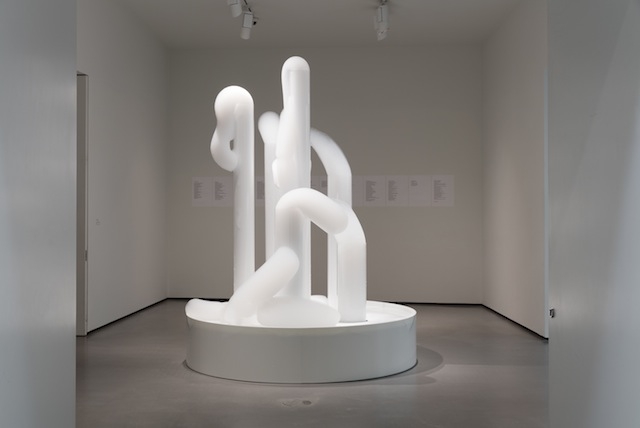The Hepworth Wakefield, Yorkshire 21 October – 19 February
Conceived as an alternative to the age-restricted Turner Prize (albeit limited to a specific medium), the Hepworth Prize for Sculpture, a new £30,000 biennial award, aims to recognise the sculptural contribution of a UK-based artist of any age, at any stage in their career. The inaugural exhibition features the work of four shortlisted artists – David Medalla, Phyllida Barlow, Steven Claydon and Helen Marten – 60 years of sculptural practice and an abundance of visual language that is sometimes poignant, sometimes playful, sometimes opaque.
Filipino artist David Medalla melds sculpture with installation, performance and kinetic art. He has reworked a number of sculptures for the exhibition, but his seminal work, Cloud Canyons (1964/2016), remains the most arresting: seemingly self-generating towers of foam creep upwards from plastic tubes and collect in clouds, bobbing gently in the slipstream of passersby. Its substance is familiar and evocative – bubble baths and warm drifts of washing-up liquid – but Medalla disrupts its friendliness with the allusions in his accompanying poem, ‘The Bubble Machine’, pinned to the back wall: fragrant coconut cream; hot hops frothing in an Edinburgh brewery; a soldier in Manila, dying beneath a flotilla of crimson hibiscus flower (‘I saw tiny bubbles coming out of his mouth / tiny rainbows / mixed with blood’). Medalla’s memories bring a new depth of meaning to the work, settling in the fertile space where language and material meet.
Next door is Phyllida Barlow’s monumental architectural offering. Entering through the cavelike underside of untitled: screestage (2013), we are invited to navigate its cement geology before emerging to the openness of an apocalyptic landscape of broken boards, punctured by one-eyed, alien-looking columns. Crudely painted in synthetic pinks, reds, yellows and greens, it is gaudy and artificial, like a stage set. Beautiful and broken, untitled: screestage is not so much viewed as populated by its audience, their presence completing the work.
Steven Claydon’s sculptures are similarly setlike and immersive. Yellow plastic panels hang in the doorways, emitting a citronella tang: floor-length mosquito traps with an abattoir aesthetic. Pushing through the plastic curtain to the other side, one comes upon a line of wall-mounted fluorescent lights that bathe the room in blue. These are the lures used in nocturnal squid-fishing, but here, removed from that context, they suggest the buzz of fastfood insect traps and the blue glare of nightclub toilets. Decontextualisation is characteristic of Claydon’s works: his repositioning of objects liquefies their meaning, allowing allusions and associations to work their way in. The rest of the room is an odd assemblage of artefacts, hybrid and obscure: African masks, camera lenses bristling with wires and antennae, a gilded pill packet and a model of a Velociraptor’s voice box – an oblique Jurassic Park reference pointing at the possibilities and pitfalls of scientific meddling. Claydon’s work is intriguing, fusing history, archaeology and anthropology in a curious narrative, under-pinned by the ambient sound of electricity thrumming gently through Charles Darwin’s prostrate bust.
The now prizewinning (the winner was announced on 17 November) display is that of work by Helen Marten (also, as of 5 December, the winner of this year’s Turner Prize), whose pictorial vocabulary is as playful as it is opaque, a seemingly omnivorous accrual of mementoes and materials. On one wall sit pastel-lacquered wooden carvings, festooned with found objects and cheap lengths of polyester; opposite, a cartoon cat strolls from one screenprinted panel to another, and along its own tail, to be greeted by a nest of tobacco pipes and a coffee-bean skull. The room is partitioned by a maze of metal strips, bent into a stretched-out shirt shape, a suitcase sitting enigmatically at its base. Marten offers no answers – only language interrupted and things made strange.
From the January & February 2017 issue of ArtReview
